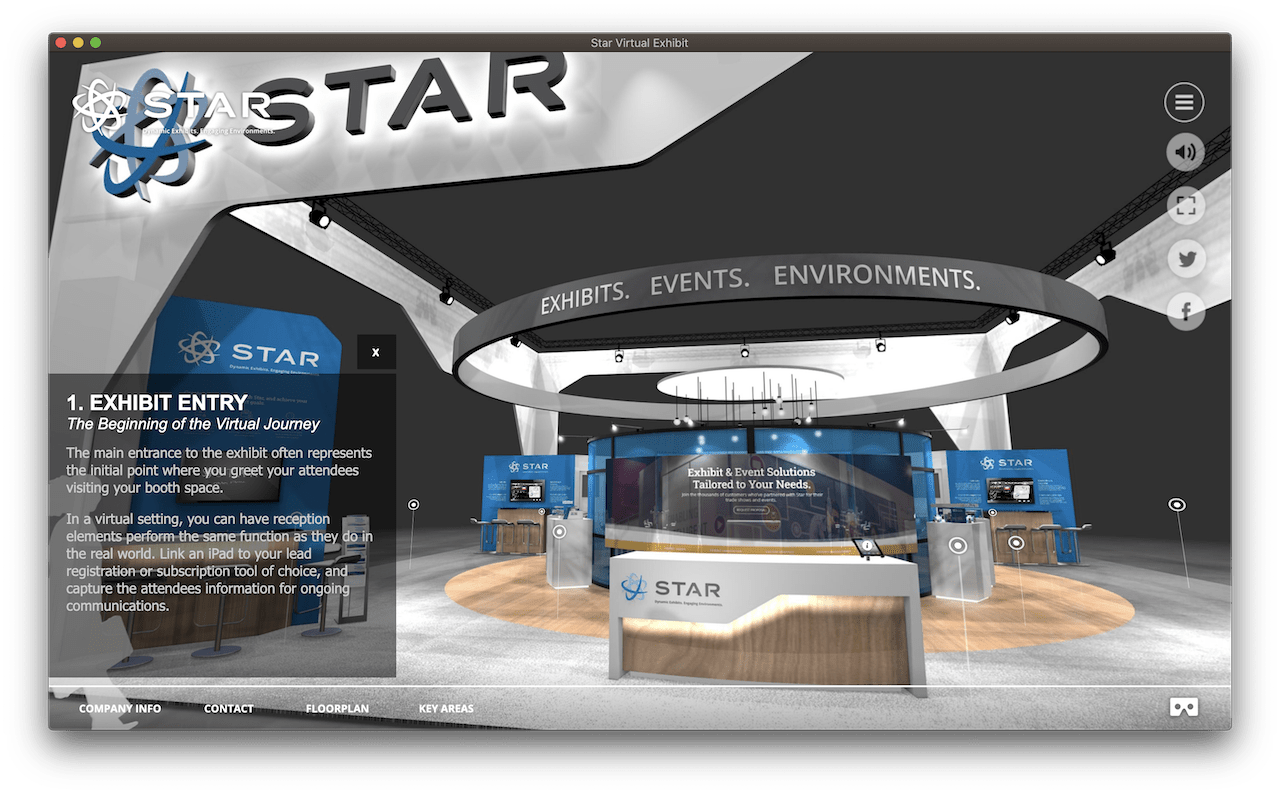We sat with Larry Holtz, Partner at Star—to talk about the latest virtual exhibit trends spurred on by COVID-19, and how virtual exhibits applies to the exhibit and events industry.
Q: What is a virtual exhibit?
A virtual exhibit is a type of interactive, and immersive 3D digital environment that mimics an exhibit that you’d see at a trade show or exposition. Virtual exhibits can be either 3D computer rendered or digital replicas of a physical exhibit captured through specialized 360 degree 3D cameras.
Like a live exhibit, a visitor navigates and explores various locations throughout the virtual environment—interacting with elements in key areas that are triggered by mouse clicks or touches. Typical things that can be achieved include:
- Registering/capturing visitor information
- Viewing product PDFs
- Viewing product images and other media
- Connecting to your company’s online channels
- Scheduling meetings
- Viewing recorded presentations and videos
- Viewing live webinars and other screencasts
Some virtual exhibits provide additional functionality. Star’s virtual exhibit offering for instance offers tracking and reporting of visitor activity. This allows the exhibitor to understand metrics such as number of visitors, click activity/history, and most popular content or areas of the exhibit.
Q: Why are virtual exhibits such a hot topic right now?
In general, the exhibit industry is always looking at innovation when it comes to presentation and enhancing the customer journey. And buying audiences are always evolving and embracing the latest ways to communicate.
But with the COVID-19 pandemic putting a short term halt to large live events and forcing people into telecommuting scenarios, it has really prompted this increased demand for solutions that cater to remote work environments and alternate business and event marketing approaches—especially from companies who relied heavily on face to face business. And while virtual trade shows and exhibits have had a limited role in the past, COVID-19 has really accelerated that virtual movement.
As we move forward from these recent experiences, and as technology continues to advance and our customer behaviors evolve, I believe we will see more of these types events and environments where there’s a blending of the experiences—between the tangibility and dimensionality of an in-person environment and the efficiencies of our online and digital tools.
An example of a Star virtual exhibit with interactive elements,.
Q: What are the ways I can I use a virtual exhibit?
- It can be used and shared through your online marketing channels like your website, email marketing and your social media.Your audience can now experience it on LinkedIn, Facebook, Twitter, etc.
- It can also be used as a pre-promotional invitation to your next trade show or a post-show follow-up to attendees or those who weren’t available to attend the trade show.
- Your virtual exhibit is a sales tool that can be used 365 days a year. You’re no longer confined to building an exhibit for a single 3-day show and then sending it off to storage.
- The virtual trade show will have the ability to track who and what the viewer is most interested in. The virtual experience will be able to support interactive demos, set future meetings or listen in on a podcast. The future and value of virtual trade shows are endless as we build in additional meeting planning tools along with other unique features. The future looks bright!
Q: I typically exhibit at trade shows. Is this replacing my trade show exhibit program?
Virtual exhibits are most definitely NOT replacing your trade show exhibit program. While they are a great enhancement to what you’re doing, and while it’s playing a bigger role at the moment specifically because of COVID-19, there are obvious, inherent and also intangible benefits that you can only get from a live trade show. So it’s essentially comparing apples to oranges.
In business interactions, there has always been a need to meet eye-to-eye to build relationships—and we don’t see that ever going away. And while a virtual exhibit helps to build a stronger communications link and maximize brand exposure to a wider audience, it can’t actually replace the experience of touching and trying out a product in person, or meeting and talking with someone face-to-face.
Q: What do you think are the main benefits of a virtual exhibit?
The benefits are numerous. Here’s some notable ones:
- A virtual exhibit helps you maintain business and marketing continuity in the midst of the COVID-19 crisis. The most immediate benefit right now, is it can be a viable way to maintain business continuity during the current COVID-19 crisis. If your show has been canceled or postponed—as an exhibitor—a virtual exhibit can help you to continue with your trade show marketing plans of showcasing product and presenting your company and brand to your targeted audience—albeit virtually. And for your customers and prospects who were going to visit you on the show floor, it’s the second closest thing to experiencing your exhibit in person at this time.
- It helps increase your reach and overall trade show exhibit marketing ROI. As a long term benefit, a virtual exhibit increases the return on investments (ROI) that you’ve made and will make with your physical trade show exhibit, by allowing your audience to experience your exhibit beyond the trade show, throughout the year and through multiple marketing channels.
- A virtual exhibit is a unique and effective marketing communications tool. It is a great addition to your marketing and marketing communications tool set. It gives you an opportunity to present your entire brand and your breadth of products/services—using a unique visual experience that brings together your other marketing tools and assets—in a more dynamic and memorable way than any website or product data sheet could.
Q: What are some things to consider when evaluating a virtual exhibit solution?
Your product and value proposition are certainly key to evaluating if a virtual exhibit is right for you. If you’ve exhibited at trade shows, or you’re already going to a trade show then you have already made a strong case for showcasing your product and services virtually. But here’s some additional things to consider:
- Understand the limits of a virtual exhibit. It can enhance your current trade show and event marketing strategy and overall marketing communications but it cannot replace in-person communications and experiences. There will be some products or services that will be more challenging to present in a virtual exhibit format. And for some specific functionality, such as live online interactions, you might still need to incorporate and utilize additional online tools to achieve that desired functionality (Luckily a virtual exhibit can integrate with many of those services pretty easily.)
- Maximize on the unique benefits of the virtual format. While there are things from the real world that you can’t replicate in a virtual exhibit, on the flip side, there are some things that you will be able to achieve simply because it’s virtual. Get creative! Work with a virtual exhibit partner who can help you think out of the box when creating the design. This is your chance to incorporate elements in your exhibit that might not have been possible on the trade show floor. You’re no longer restricted by booth space, show regulations, or fabrication or shipping considerations!
- Evaluate the quality of your online and digital content. One of the main things to consider is the quality of your online and digital content. To be effective, your virtual exhibit should utilize your online and digital marketing content whenever possible. This includes content from your website, your social media channels, and all the other digital content in your marketing arsenal (product PDFs, presentation files, video and image assets, etc.) So make sure that your online and digital content is current and ready to use in your exhibit!
- Be prepared with your marketing communication tools and marketing automation processes. Going hand in hand with your marketing content, the tools and processes you use to capture, track and manage your customer and marketing communications should ideally be in place and ready to integrate with your virtual exhibit. At a minimum, you should have a way to capture visitor information and organize interests in specific products and services. This can be done using email marketing and marketing automation platforms such as MailChimp, ActiveCampaign, Hubspot.
Q: Are there are other ways I can use Star’s virtual environment services?
A virtual exhibit is just one way to utilize Star’s virtual environment services.
Beyond creating your own virtual exhibit, Star’s virtual environment services can also help trade show organizers develop and deploy entire virtual trade shows or conferences, bringing together groups of virtual exhibitors and sponsors.
And beyond events based virtual projects, Star can help you create and deploy other virtual environments such as virtual retail and commercial spaces, show rooms, galleries and museums.
To learn more about Star’s virtual exhibit and environment services, visit the Star Virtual Exhibits page.



